Commercial Whaling 101
Despite an international ban on commercial whaling since 1986, the animals are still being hunted and killed across the world’s oceans, with devastating impacts on global populations.
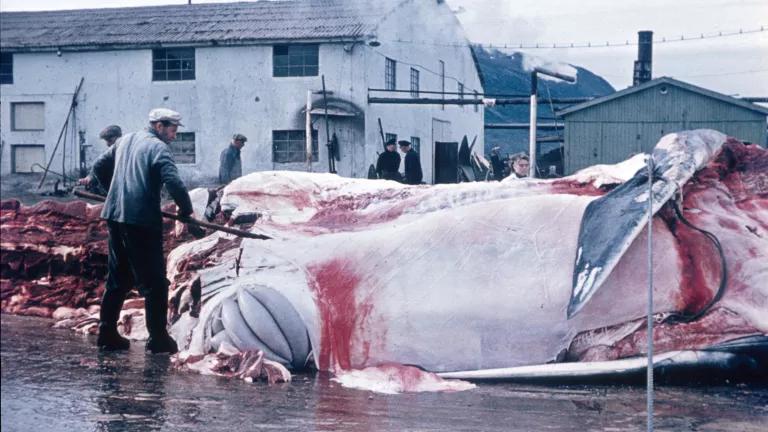
Whalemen dissect a great whale ashore of fishing town Svolvaer, Norway in 1966.
iStock/atlantic-kid
Jump to Section
- What Is Commercial Whaling?
- The History of Whaling
- Commercial Whaling Today
- The Future of Commercial Whaling
What Is Commercial Whaling?
Commercial whaling is the practice of hunting and killing whales for the purpose of selling and trading their meat and other products derived from them.
Scientists estimate that 2.9 million whales were killed for commercial purposes in the 20th century, causing the catastrophic decline of global whale populations. By some estimates, sperm whales were depleted to one-third of their pre-whaling population, and blue whales by up to 90 percent.
In 1946, the International Whaling Commission (IWC) was established under the International Convention for the Regulation of Whaling (ICRW) to oversee the proper management of whale stocks and orderly development of the whaling industry. In a landmark agreement in 1982, IWC members decided to establish a moratorium, or a temporary ban, on commercial hunting to allow whale stocks to replenish. The moratorium came into force in 1986 and remains in place today. The commission also designated a sanctuary area in the Indian Ocean in 1979 and another in the Southern Ocean in 1994 to address the need for long-term protection for all the whale species for which the IWC has acknowledged conservation responsibility and for ecosystem restoration. Commercial whaling is prohibited in both sanctuaries.
Despite the moratorium on commercial whaling and the IWC’s greater focus recently on conservation, some countries continue to engage in commercial whaling activities. In 2019 Japan withdrew from the IWC and resumed whaling in its coastal waters. Norway registered an objection to the moratorium and Iceland lodged a “reservation”—a move disputed by many countries as being contrary to international law—allowing them to resume commercial whaling.
Some countries with Indigenous or aboriginal populations also continue to hunt whales for subsistence purposes. This practice is called aboriginal subsistence whaling. From the outset, the IWC and its members recognized that subsistence whaling is not the same as commercial whaling (and thus not subject to the moratorium), and that certain aboriginal peoples have a right to hunt a limited number of whales to meet nutritional and cultural needs.
Special permit whaling, known as “scientific” whaling, is also categorized differently by the IWC and not subject to the moratorium on commercial whaling. Under a provision in Article VIII of the ICRW, countries are permitted to kill whales for scientific research purposes. However, the IWC does not regulate scientific whaling—countries are asked to submit special permit research proposals to the IWC for scientific scrutiny, but the permits are issued by individual countries.
The History of Whaling
People around the world have been hunting whales for thousands of years, primarily for their meat and blubber. Norwegians were among the earliest confirmed whale hunters, having begun the practice as far back as the ninth century. Several other cultures near the ocean also forged whaling traditions, like the Inuit, who hunted in the Arctic, and the Basque, who hunted in the Atlantic.
Researchers have found evidence of whaling extending as far back as 6000 BC in ancient tools that resemble early harpoons with ropes or lines attached. One of the oldest known hunting strategies was to bring several small boats alongside the whale, scare it toward shore, and kill it when it landed on the beach.
Whaling changed irrevocably around the 17th century, when advances in technology and increased demand for whale products combined to elevate the practice to a major industry. A Norwegian whaling pioneer named Svend Foyn is credited with heralding modern commercial whaling by developing two key innovations: the steam-powered whaling ship, first launched in 1863, and the harpoon cannon, created in 1868, which shot a harpoon that actually exploded inside the whale once it landed. These two technologies alone allowed whalers to pursue significantly larger animals than previously imagined.
The industrial age heralded a time of high demand for whale oil, which was used as a fuel for lamps and for the production of soap. Among the most popular types of baleen whale to hunt and harvest for oil were blue whales, bowhead whales, and right whales (so named because they were the “right” kind to hunt, since they moved slowly and would float after being killed). Sperm whales—which are toothed—were also sought for the oil that could be extracted from the spermaceti organ in its head cavity. An average-size sperm whale could produce around 25 to 40 barrels of oil.
Whales were also hunted for their baleen, or “whalebone,” a series of fringed plates that hang in baleen whales’ mouths and serve as a filter to strain food from saltwater. Whalebone was used to make corsets, hat brims, umbrella ribs, riding crops, and buggy whips.
In the United States, whaling entered its golden age following the War of 1812. In addition to serving as a major economic engine, 19th-century whaling was, as documentarian Ric Burns described it, an “extraordinarily primal, existential confrontation between human beings and what was really the last frontier of untamed nature, the oceans of the world.” It was during this time that the Nantucket-based whale ship Essex sank in the Pacific after pursuing a sperm whale, a turn of events that partially inspired Herman Melville’s Moby-Dick.
Whaling finally declined toward the end of the 19th century with the development of new technologies like kerosene, reducing the need for whale products.
Basque whaling
The Basque people, whose origins lie in the Pyrenees region straddling the border between modern France and Spain, have been hunting right whales since at least the 11th century. Though they weren’t the earliest people to engage in the practice, they were among the first to do it commercially, initially plying their trade in the Bay of Biscay. As master mariners, the Basques were also pioneers when it came to navigating the waters between Europe and the New World. In the 1530s they established a whaling station in Red Bay, in easternmost Canada, where they hunted whales, butchered them, and rendered their fat into oil, which was then sold in Europe. The station, considered “an outstanding example” of the tradition of whale hunting established by the Basques, was named a UNESCO World Heritage Site in 2013. In terms of archaeological remains, it is thought to be “the most extensive, best preserved and most comprehensive whaling station of this type.”
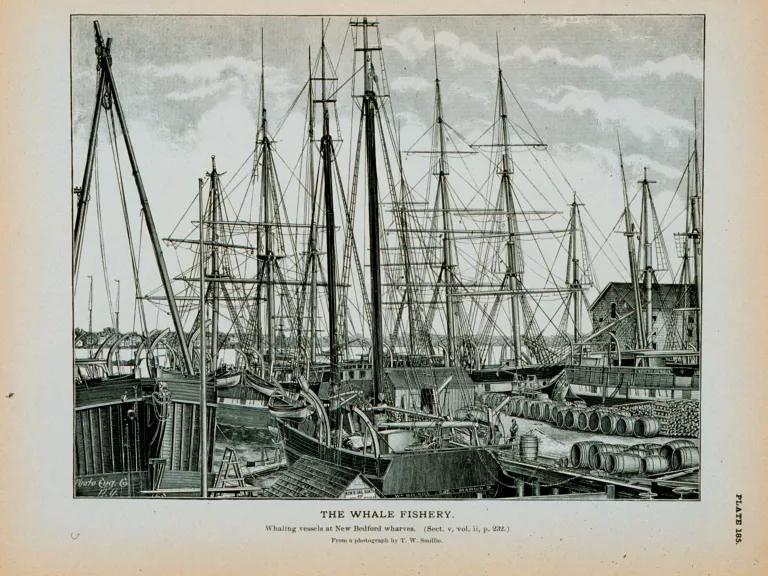
Whaling vessels fitted out at New Bedford wharves
From a photograph by T. W. Smillie
Nantucket whaling
Settlers of Nantucket, just south of Cape Cod, began as a small island community of farmers and sheepherders, though when whales did happen to wash ashore, they were coveted for their oil. By the 1690s Nantucketers had begun taking a proactive approach, launching small boats in pursuit of right whales. Whale houses on elevated platforms were built along the water’s edge, and when one of the animals was spotted, boats were sent off to capture it.
Around 1715, Nantucket whalers began venturing farther into the ocean in search of sperm whales. While the oil taken from sperm whales’ head cavities was unmatched in quality, these whales tended to dwell in the deepest parts of the ocean, meaning whalers needed to be able to travel up to 50 miles from the coast and then bring their haul back to shore for processing. By the mid-18th century, Nantucket was launching larger whaling ships outfitted with the necessary equipment to process their catch and extract the oil onboard. For the next century, Nantucket whale ships trawled the globe on expeditions that lasted up to five years.
Inuit and Alaska Eskimo whaling
The Inuit began hunting bowhead whales around Greenland roughly 4,000 years ago, making them seasoned whalers even before they took up residence in Arctic Canada around 1,000 years ago. Much like today, early Inuit relied on a variety of animals for food, but whales formed the backbone of society in ways both practical and spiritual.
In 1972, Canada’s federal government prohibited commercial whaling from its ports after bowheads were hunted to the brink of extinction. When the IWC moved to establish the global moratorium on commercial whaling in 1982, Canada left the commission on the basis that the country lacked “any direct interest in the whaling industry or in the related activities of the Commission.” This meant that the Inuit were ineligible to hunt whales under the IWC’s subsistence whaling guidelines.
Aboriginal subsistence whaling—the hunting of otherwise protected whales by certain Indigenous people to satisfy subsistence needs—is categorized differently by the IWC and is not subject to the moratorium. The commission recognizes that aboriginal subsistence whaling does not seek to maximize catches or profit, and part of its mandate is “to ensure that hunted whale populations are maintained at (or brought back to) healthy levels, and to enable native people to hunt whales at levels that are appropriate to cultural and nutritional requirements in the long term.” The IWC sets catch limits for subsistence whaling based on advice from a scientific committee.
Most Inuit communities voluntarily limited or stopped traditional whale hunting activities in the 1970s, although, starting in 1991, they were once again allowed to hunt whales under a quota. In 2014 hunters in the Nunavut Territory killed their first bowhead whale in a century.
Whaling has also been part of the Alaska Eskimo culture for thousands of years. The whaling villages of Alaska are among the most remote communities in the world, and the Inupiat and Yupik people rely on subsistence hunting of the bowhead whale for their survival.
Prior to 1997, only Alaska Eskimo Whaling Commission (AEWC) hunters had documented their subsistence needs for bowhead whales, and thus were the only people allowed to hunt under the IWC’s bowhead whale subsistence quota. In 1997, Russian subsistence hunters obtained the right to hunt whales from the Bering-Chukchi-Beaufort Seas. Currently the IWC’s catch limit for the Bering-Chukchi-Beaufort Seas’ stock of bowhead whales stands at 392 for the period 2019–2025, with no more than 67 whales struck in any one year.
Aside from the United States and Russia, countries with aboriginal populations that still hunt for subsistence purposes include Greenland and Saint Vincent and the Grenadines.
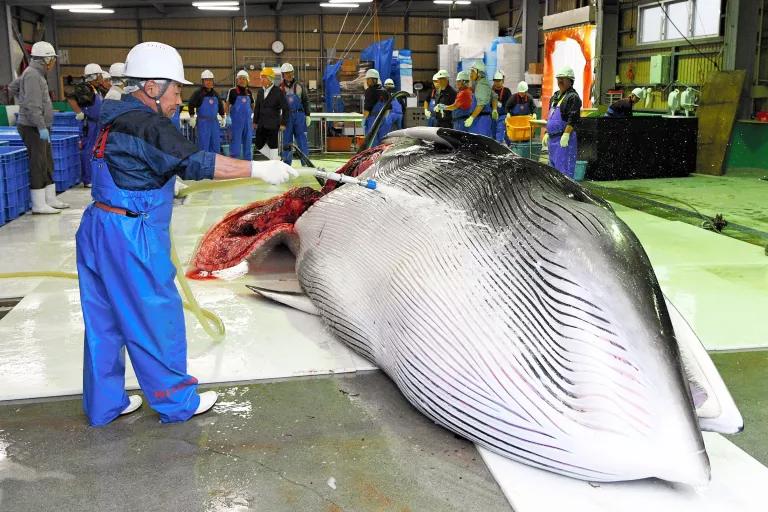
Fishermen prepare to process a minke whale at Kushiro Port in Hokkaido on July 1, 2019, a day after Japan withdrew from the International Whaling Commission.
Getty/The Asahi Shimbun / Contributor
Commercial Whaling Today
Japan
On December 26, 2018, the Japanese government announced that it would withdraw from the IWC so it could resume commercial whaling in Japanese waters, and on July 1, 2019, it did. Prior to its withdrawal, Japan’s last commercial hunt had been in 1986, although it had actually continued killing whales by exploiting a loophole in the IWC rules that allowed whaling strictly for “scientific research” purposes. Japan’s stated objectives for post-moratorium whaling for “science” included accumulating data to eliminate uncertainty over the status of whale stocks, investigating stock structure and feeding ecology, and gathering information that the country considered necessary to calculate commercial catch limits of minke and sei whales. IWC scientists, however, have denounced Japan’s lethal whaling program as “unscientific,” arguing that the science behind the program “has not passed a reasonable standard of peer review.”
Despite a 2014 United Nations order demanding that Japan abolish its whaling program in Antarctica, the country pressed ahead with its 2015–2016 season, declaring that it had fashioned a new plan that would allow it to kill 333 minke whales annually in the name of research. Nearly 500 marine scientists sent a letter to the IWC decrying Japan’s so-called scientific program.
Regardless of its decision to go rogue and formally resume commercial whaling, the demand for whale meat in Japan has plummeted. The country’s consumption of whale meat peaked in 1962 at 226,000 tons, but by 2017 the number had dropped to just 3,000 tons. Though Japan also imports whale meat from nations like Iceland and Norway, the lack of domestic demand means that as of April 2019, some 3,500 tons of the meat was sitting in freezers awaiting purchase. This is despite several marketing efforts in Japan to promote whale products to consumers, including holding festivals that showcase whale cuisine and serving whale meat on school lunch menus.
Japan has also continued its controversial dolphin hunts. The Oscar-winning 2009 documentary The Cove shed light on this annual practice held in the town of Taiji, located on the southeastern coast of Japan’s main island. The hunt sees dolphins driven into a cove where most are slaughtered for their meat with knives in shallow waters. The rest are hand-picked to be sold to marine parks and dolphinariums. Because they are considered small cetaceans, dolphins do not fall under the jurisdiction of the IWC (which regulates the hunting of great whales) and are not covered by the ban on commercial whaling.
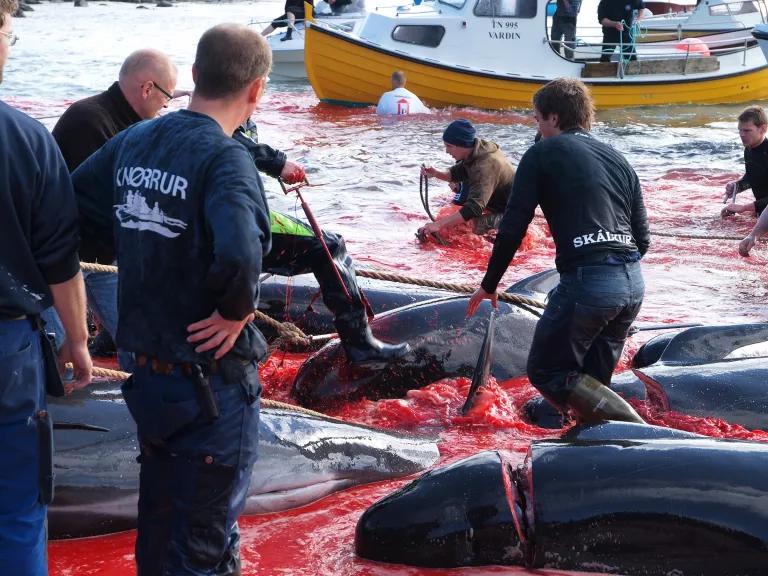
Long-finned pilot whales are beached and killed in Tórshavn, Faroe Islands in 2010
iStock/Kasper Solberg
Faroe Islands
On the Faroe Islands, halfway between Norway and Iceland, whaling has been a traditional practice for more than 1,000 years. But unlike other places with long histories of whaling, the Faroese have not abandoned their original technique, called the grindadráp, or grind. During a grind, dolphins and pilot whales are herded toward the shore by a flotilla of small boats and then killed with knives. There is no formal industry for the grinds, and specific circumstances like weather, currents, and a sufficient number of available participants must be met in order for a grind to take place.
Once the animal is dead, the meat is apportioned to the community using a traditional calculation. But in recent years, studies have found unhealthy levels of toxins in the pilot whales’ meat, which can negatively impact many aspects of human health, from fetal development to the risk of Parkinson’s disease. Additionally, conservation and animal welfare groups are working to dissuade the Faroese from whaling, with efforts given a surge of energy following the widespread release in 2018 of images depicting a cove dyed red with blood from the slaughter.
Still, whaling is legal for the Faroese on the basis that harvested meat is shared rather than sold. And because pilot whales are also considered small cetaceans, they are not covered by the IWC moratorium on whaling.
Iceland
Iceland was a founding member of the IWC and was bound by the moratorium, but it continued to whale after the ban took effect in 1986 under a special permit provision in Article VIII of the ICRW for “scientific whaling.” From 1986 to 1990, Iceland killed an average of 90 whales per year and exported most of the whale products to Japan. It withdrew from the IWC in 1992 but rejoined in 2002 and lodged a “reservation” to the moratorium, not recognized as legal by many countries, including the United States. Iceland resumed commercial hunting of minke and fin whales under its reservation to the ban in 2006, and the United States imposed diplomatic sanctions on Iceland in 2011. No trade sanctions were imposed, however, in the hope that diplomacy would be enough to persuade Iceland to stop commercial whaling and trade. It wasn’t.
In 2013 Iceland’s Ministry of Fisheries and Agriculture announced that it would allow commercial whaling to continue for at least the next five years. President Obama acknowledged that Iceland’s international trade in fin whale meat and products undermined the Convention on International Trade in Endangered Species (CITES). And again, the United States imposed diplomatic sanctions.
In 2016 Iceland’s only fin whaling company, Hvalur hf, suspended its activities due to restrictive import regulations and slowing demand in Japan, its biggest market. But after Japan relaxed regulations on Icelandic imports, Iceland’s whaling industry once again became commercially viable. Hvalur hf resumed the hunting of endangered fin whales in the spring of 2018, implementing the highest quota in decades.
But in 2019 Iceland again suspended commercial hunts of minke and fin whales. IP útgerð, a company that hunts minke whales, said that it would “skip” whaling season and concentrate instead on sea cucumbers due to reduced demand. (The majority of the demand for minke whale meat had come from tourists from the United States and United Kingdom; in 2017, 60 percent of minke whale meat was bought by restaurants.) Hvalur hf also suspended whaling in 2019, citing a need for ship repairs and difficult market conditions in Japan, where 100 percent of the company’s catch is exported.
However, conservation bodies and environmentalists remain vigilant. Icelandic whaling companies have been known to resume whaling activities after temporary suspensions; moreover, in February 2019, Minister of Fisheries and Agriculture Kristján Þór Júlíusson approved the hunting of fin whales and minke whales until 2023.
Norway
Like Iceland, Norway continues to hunt minke whales despite the IWC’s commercial whaling ban, citing an “objection” to the moratorium (under IWC regulations, any member country may lodge an objection to an IWC decision within 90 days and thus be exempt from that decision). While the hunts were initially conducted under the guise of science, commercial whaling was openly resumed in 1993. This decision received strong international criticism, especially from the United States, which threatened to impose sanctions on Norwegian seafood products. However, after discussions between the two countries, the United States lifted the threat and Norway continued commercial whaling.
In 1993 Norway caught 157 minkes; in 2014 it caught its highest number, 736. As of August 2018, Norway had killed 14,306 minke whales since the moratorium took effect. Still, the country’s whaling industry has declined in recent years. In 2018 it announced it would increase its annual whaling quota by 28, raising it to 1,278 in hopes of reviving interest in the industry. It didn’t appear to be working: In 2017 there were only 11 whaling vessels, compared with 350 in 1950.
Of course, now that Japan has withdrawn from the IWC, there is concern in the European Union that exports of whale products will once again increase. While neither Norway nor Iceland are E.U. members, the European Parliament in 2017 passed a resolution to request the European Commission to ban the use of E.U. member ports for shipping whale meat to Japan, and several shipping companies have refused to transport whale meat.
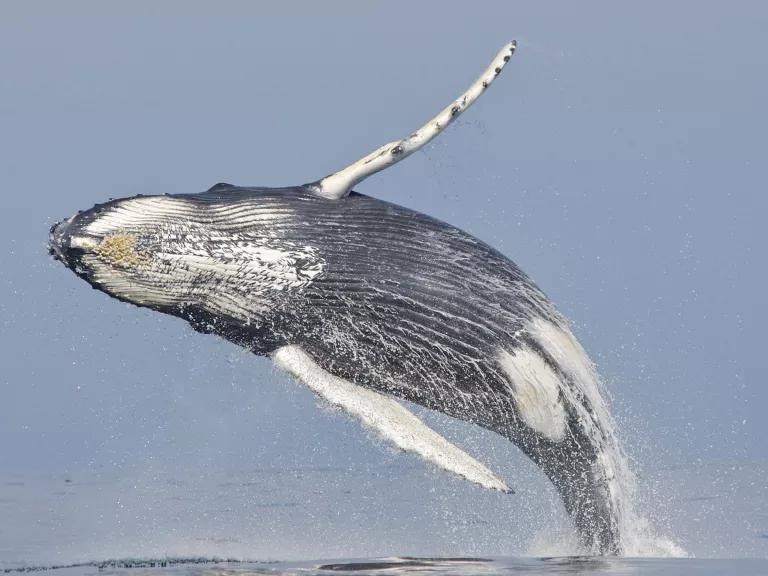
A humpback whale
NOAA Fisheries Permit #14245/Elliott Hazen
The Future of Commercial Whaling
In April 2010, the IWC announced a proposal that would have suspended the 1986 moratorium and legalized commercial whaling, in an attempt to bring Japan’s, Norway’s, and Iceland’s rogue whaling under the control of the commission. But in a meeting in June of the same year, the IWC decided to postpone the “compromise” proposal, upholding the ban.
Despite some countries’ decisions to continue commercial whaling activities, consumption of whale meat is trending down. In Japan, where whale meat is not commonly eaten, efforts to boost whale meat consumption, such as with nostalgic promotional ads aimed at older consumers, have not had much impact.
The future of Norway’s whaling industry also seems to be in doubt as companies deal with low catch numbers, falling prices for whale meat, and declining domestic interest. In a 2019 survey commissioned by a number of conservation groups, only 4 percent of Norwegians indicated they ate whale meat “often,” while two-thirds either didn’t eat it at all or did so “a long time ago.”
In an effort to boost profits, Japan, Norway, and Iceland have looked to the production of feed for animals. In 2016, the London-based nonprofit Environmental Investigation Agency and the U.S.-based Animal Welfare Institute released documents showing that Rogaland Pelsdyrfôrlaget, the largest manufacturer of animal feed for Norway’s fur industry, bought or used more than 113 metric tons of minke whale products (the equivalent of about 75 whales). A Japanese online food company faced criticism in 2013 for selling dog treats made from imported Icelandic fin whale meat.
As consumption of whale meat declines globally, an increasing number of people are becoming interested in seeing the animals in the wild rather than eating them, and the whale-watching industry—which depends on whales being kept alive—has become an important aspect of tourism in countries around the world.
Japan, for example, has seen a sharp rise in whale watching. From 2008 to 2015, the International Fund for Animal Welfare (IFAW) found that the number of whale watchers in Japan increased by more than 40,000 over that period, generating around $8 million in 2015 alone. What’s more, IFAW estimates that around two-thirds of those boarding whale-watching boats were Japanese nationals, not tourists. Even those who support whaling in Japan have acknowledged that younger generations view the animals as creatures to be protected rather than hunted as a food source.
In Iceland, where tourism has accounted for more than 8 percent of the country’s GDP in recent years, whale watching has also become a popular and highly profitable industry. In fact, it is now more profitable than whale hunting. More than 100,000 tourists each year (one in eight visitors) go whale watching in Iceland; in 2010 whale-watching tours directly contributed $6.3 million to the national economy and had a total economic impact of $16.4 million. Some tour operators have said that it was “likely” whale-watching tourism would be even more valuable to the Icelandic economy without whaling, which many consider damaging to Iceland’s image as a nature destination. A 2003 study found that more than 91 percent of surveyed whale watchers said they would not go whale watching in a country that hunted whales, and 79 percent said they would boycott a country that conducted hunts of cetaceans.
Luckily for whale watchers, many species have benefited from the IWC’s moratorium on commercial whaling, saving several great whale populations from extinction.
In addition to its work regulating whaling, today’s IWC also works to address a wide range of conservation issues such as sustainable whale watching. To this end, it collaborates with governments, organizations, and scientists to manage the impact of whale watching on the animals’ natural behavior, including their ability to feed, rest, and raise their young. In 2011 the commission introduced a Strategic Plan for Whale Watching, which establishes sustainable practices. The IWC updated that Strategic Plan in 2018. The IWC also rolled out a Whale Watching Handbook, a “flexible and evolving tool incorporating international best practice, educational resources and a summary of the latest, relevant scientific information.”
Like any industry that combines nature and tourism, whale watching should be regulated to minimize threats to the animals, which are now also facing impacts of climate change, pollution, ocean noise, and bycatch in fishing gear. Harboring an appreciation for the creatures in their own right—not as a source of food—is a very good place to start. And in light of the grave and growing threats to the survival of cetaceans, the end of commercial whaling has never been more necessary.
This NRDC.org story is available for online republication by news media outlets or nonprofits under these conditions: The writer(s) must be credited with a byline; you must note prominently that the story was originally published by NRDC.org and link to the original; the story cannot be edited (beyond simple things such as grammar); you can’t resell the story in any form or grant republishing rights to other outlets; you can’t republish our material wholesale or automatically—you need to select stories individually; you can’t republish the photos or graphics on our site without specific permission; you should drop us a note to let us know when you’ve used one of our stories.

Can Anything Be Done to Stop Overfishing?
Biodiversity 101
In Landlocked Vienna, a Humpback Spreads a Powerful Message